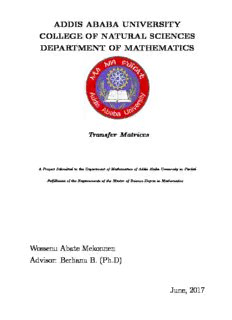
Wossenu Abate Mekonnen PDF
Preview Wossenu Abate Mekonnen
ADDIS ABABA UNIVERSITY SCHOOL OF GRADUATE STUDIES COLLEGE OF HUMANITIES, LANGUAGE STUDIES, AND JOURNALISM AND COMMUNICATION DEPARTMENT OF LINGUISTICS LANGUAGE USE IN AKSUM LINGUISTIC LANDSCAPE BY TEKLAY GUESH JUNE 2013 ADDIS ABABA, ETHIOPIA ADDIS ABABA UNIVERSITY SCHOOL OF GRADUATE STUDIES COLLEGE OF HUMANITIES, LANGUAGE STUDIES, AND JOURNALISM AND COMMUNICATION DEPARTMENT OF LINGUISTICS LANGUAGE USE IN AKSUM LINGUISTIC LANDSCAPE BY TEKLAY GUESH A THESIS SUBMITTED TO THE DEPARTMENT OF LINGUISTICS IN PARTIAL FULFILLMENT OF THE REQUIREMENTS FOR THE DEGREE OF MASTER OF ARTS IN LINGUISTICS ADVISOR BAYE YIMAM (PROFESSOR) JUNE 2013 ADDIS ABABA, ETHIOPIA LANGUAGE USE IN AKSUM LINGUISTIC LANDSCAPE APPROVED BY: DATE SIGNATURE _________________ _____________ ____________ ADVISOR ___________________ ______________ _____________ EXAMINER _________________ _____________ _____________ EXAMINER Declaration I, the undersigned, declare that this thesis is my work, has not been presented for a degree in any other university and all sources of materials used for this research work has been duly acknowledged. Teklay Guesh ______________________ June, 2013 School of Graduate Studies Addis Ababa University CONFIRMATION This thesis has been submitted for examination with my approval as thesis advisor Prof. Baye Yimam Advisor ______________________ June, 2013 Addis Ababa University School of Graduate Studies ACKNOWLEDGEMENTS I would like to express my sincere gratitude and appreciation to my advisor Prof. Baye Yimam for his valuable guidance, insight and useful comments throughout the research. My special thanks also go to Ato Hagos Abrha, a PhD student at Addis Ababa University and Samrawit Bekele, my colleague in Addis Ababa University for their comments, suggestions and immeasurable moral and material support. I would also like to thank my friends and colleagues Haile Gezae, Hadgu Teka, Haftay Gebre Egziabiher for their unreserved and continuous encouragement and friendly support. I also wish to extend my thanks to Addis Ababa University for the financial assistance that was indispensable for the successful accomplishment of the study. Finally, my appreciation goes to my assistance, who have been so willing to help me in the process of the data collection. i ABSTRACT The purpose of the study is to examine the language use in Aksum linguistic landscape. In order to meet this purpose the required data are collected through photographing, observation, semi-structured interviews held with business owners and customers. The result of the study has been analyzed quantitatively and qualitatively to determine the order of languages, prominence of languages, translation, transliteration, mixing of languages, characteristics of multilingual signs and language choice in the government and private signs. According to the findings, Amharic and Tigrigna are the most prominent languages in the linguistic landscape. The distribution of these languages differs across government and private agencies in the language choice and categories on signs. In the government signs Tigrigna is more visible. This might be due to the language policy practices of the government agencies. Amharic is dominant in private signs. This is due to the objective of business owners to attract customers who come from different parts of Ethiopia. The findings also show that English is visible in the public space due to status as an international language and the fact that Aksum is a tourist destination. The study reveals that Tigrigna signs show structural variations in the position of heads in phrases. There is also code-mixing in translation of texts in signs. There are word for word translations and transliterations of texts in signs. ii CONTENTS Page Acknowledgments……………………………………………………………………………..i Abstract…………………………………………………………………………………………ii Table of Contents……………………………………………………………………………iii List of Tables……………………………………………………………………..…….…..….v List of Figures………………………………………………………………………………..vi CHAPTER ONE INTRODUCTION 1.1. Background of the study………………………….………..…………………..1 1.2. The Study Area…………………….…………………….………………………..3 1.3. Statement of the Problem……………………….….……………………….….3 1.4. Objective of the Study……………………………….……………………….....4 1.5. Significance of the Study…………………..…………………………………...5 1.6. Scope and Limitations of the Study…………...….…….…………………...5 CHAPTER TWO Conceptual Framework and Review of Related Empirical Studies 2.1. Conceptual Framework……..………………………………….……………… 6 2.1.1. The Concept of Linguistic Landscape…..….…………………………6 2.1.2. Main Functions of Linguistic Landscape...………………..………..8 2.1.3. Public Space………………………….…………………………………..10 2.1.4. Language Use in Individual Signs………………………….…….…11 2.1.5. Structural Principles ………………………………….. ……………..15 2.2. Review of Related Empirical Studies……………………......................18 iii CHAPTER THREE RESEARCH METHODOLOGY 3.1. Survey Areas……….……………………..……………………….…………..21 3.2. Survey Items…………………………………………………….……………..22 3.3. Coding Signs ……………………………………………………………..…...23 CHAPTER FOUR DATA PRESENTATION, ANALYSIS AND INTERPRETATION 4.1. Language Use in Aksum Linguistic Landscape………………….……..26 4.1.1. Distribution of Monolingual Signs………………………….…….27 4.1.2. Distribution of Bilingual Signs……..………...........................30 4.1.3. Distribution of Trilingual Signs…………………………………...35 4.2. Language Choice in Government and Private Signs..…………………36 4.2.1. Categories of Signs in Government and Private Signs………...37 4.2.2. Language Use in Government and Private signs ……..…..……39 4.3. Language Visibility and Language Prominence ……………….……….43 4.3.1. Pattern of Language Appearance in Bi-/Trilingual Signs……44 4.3.2. Font Size of Texts in Bi-/Trilingual Signs……………………….48 4.4. Translation, Transliteration and Mixing Situations….………………..51 CHAPTER FIVE SUMMARY, CONCLUSION AND RECOMENDATIONS 5.1. Summary and Conclusions………………….………………………..……56 5.2. Recommendations…………………………………………………………....58 REFERENCES……………………………………………………………………………..59 APPENDIXES iv List of Tables Table 1: Distribution of monolingual languages ……………………………….…..27 Table 2: Distribution of bilingual languages…………………………….…………..30 Table 3: Distribution of trilingual languages……….……….………….…………..35 Table 4: Categories of signs in government agencies…..…………..……………...37 Table 5: Categories of signs in private agencies……………………...……..………38 Table 6: Distribution of languages in government and private agencies………40 Table 7: Distribution of languages in their order of appearance..………………44 Table 8: Font size in bi-/trilingual languages…………………………………..…..48 Table 9: Translations, transliterations, and mixing in multilingual signs……51 v List of Figures Figure 1: Amharic sign…… ………………….…………………………..…………….28 Figure 2: English sign …..……………………..…………………….…......…..…… 28 Figure 3: Geez sign …. ……………………………………………….…..………..…. 29 Figure 4: Tigrigna sign …………..………………………………….…………….……. 29 Figure 5: Amharic- English sign. ………………………………….………..…………32 Figure 6: Tigrigna-English sign .…….……….…………..…….………………………32 Figure 7: Geez-English sign …….…….….…….……………..…….……..………..…33 Figure 8: English-Italian sign …….…………………………………………...……….33 Figure 9: English- Fidäl sign……..……………….…..……..…….……...……......34 Figure 10: Amharic-Arabic-English trilingual sign…………..……..…….………..35 Figure 11: Tigrigna-Amharic-English trilingual sign……...……………….………36 Figure 12: Government Tigrigna sign……………….…………………..…..………..39 Figure 13: Government Tigrigna sign…………………………….…..……………….41 Figure 14: Government Tigrigna sign ………………….…….…..……………………42 Figure 15: Private English sign……………………………...……..…………..……….42 Figure 16: Amharic-English vertical signs………..……..………….………………..45 Figure 17: Amharic-English horizontal signs …………..…..………………..……..46 Figure 18: Tigrigna-English vertical signs…………………..……….…………..…..46 Figure 19: English-Tigrigna vertical signs……………………..…..………….……..47 Figure 20: English-Italian vertical sign..…...…………..…...….….…………..…...47 Figure 21: Large Font Size for Amharic in Amharic-English Sign…………….49 Figure 22: Large Font Size for Tigrigna in Tigrigna-English Sign …………………………………………………………….…………….…….50 vi
Description: